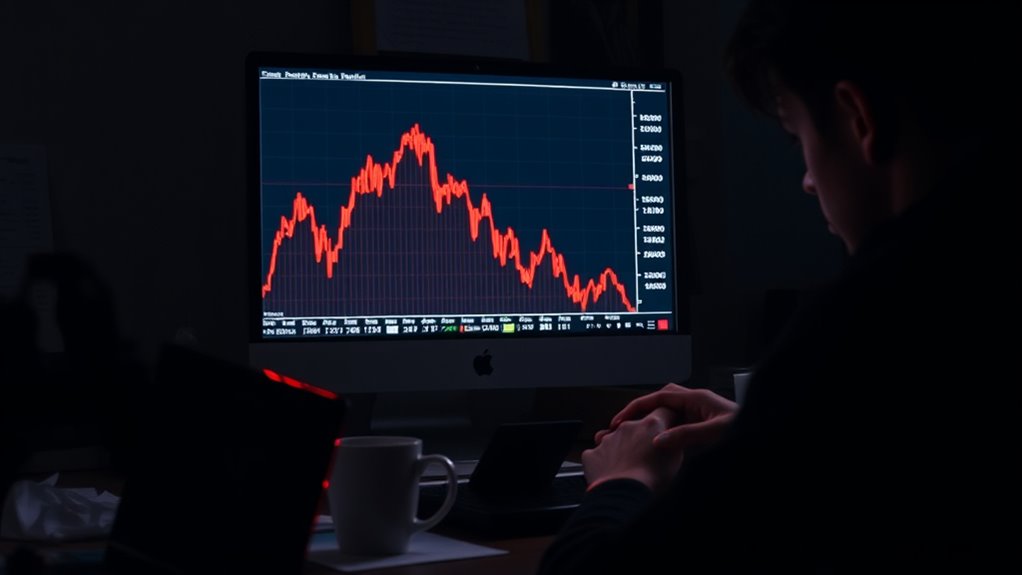The Federal Reserve’s interest rate decisions and rising recession fears are creating a perfect storm for Bitcoin and crypto crash predictions. Higher rates typically reduce liquidity, making cryptocurrencies less attractive. Market volatility increases investor anxiety, causing sell-offs and price drops. Current economic indicators suggest a cautious approach, with potential declines in Bitcoin’s value. If you want to discover the latest strategies and predictions regarding this volatile market, there’s much more to explore.
Key Takeaways
- Federal Reserve interest rate hikes typically lead to decreased liquidity, making cryptocurrencies like Bitcoin less attractive to investors amid economic uncertainty.
- Market volatility and rising fears of a recession can trigger sell-offs, further driving down cryptocurrency prices and impacting overall market sentiment.
- Analysts predict Bitcoin may decline to around $57,000 due to current market conditions, with historical patterns suggesting similar downturns during past rate hikes.
- Institutional investors are cautious, with 83% planning to increase crypto holdings by 2025, but current economic fears may temper this interest.
- Regulatory clarity can enhance market resilience; however, ongoing uncertainties and fears of a financial crisis could exacerbate market instability and crash predictions.
The Federal Reserve’s Influence on Crypto Markets

As the Federal Reserve adjusts interest rates and manages monetary policy, you might notice significant impacts on the crypto markets. Higher interest rates often make traditional investments like bonds more appealing, which can draw capital away from cryptocurrencies. Conversely, when the Fed cuts rates, liquidity increases, encouraging investment in riskier assets like crypto. These interest rate changes can create market volatility, directly affecting crypto prices and investor sentiment. Additionally, the Fed’s actions in managing inflation and maintaining financial stability play a crucial role in shaping your perception of cryptocurrencies. Understanding these dynamics helps you navigate the crypto landscape more effectively and make informed investment decisions amid the Fed’s monetary policy shifts. Furthermore, the current interest rate range of 4.25% to 4.5% highlights the ongoing caution investors must exercise in this volatile environment. The Federal Reserve’s monetary policy is often seen as a key driver behind market trends, influencing how investors perceive value in cryptocurrencies. As a result, the potential for tax-efficient growth through investment strategies like a Bitcoin IRA becomes increasingly relevant during periods of economic uncertainty. In such times, considering Gold IRA tax implications can provide additional insights into securing your investments. Additionally, diversifying your portfolio with Gold IRA fees can help mitigate risks associated with market fluctuations.
Recession Fears and Their Impact on Cryptocurrency Values

While economic uncertainty looms, fears of a recession can significantly shake the cryptocurrency market. You might notice that both traditional and crypto markets experience sharp declines, with Bitcoin’s price often taking a hit. Total cryptocurrency market capitalization dropped to $2.71 trillion, indicating widespread market distress. Trade tensions, like those between the U.S. and Canada, add to this volatility, creating a ripple effect on values. As investor anxiety rises, many choose to sell, leading to reduced liquidity and market sell-offs. Historically, downturns in the U.S. economy have global implications, affecting sentiment and asset prices worldwide. During these periods, cryptocurrencies often see price fluctuations, followed by potential recoveries. Notably, new holders currently control 50% control of Bitcoin supply, which could exacerbate market reactions. Furthermore, the use of automation in data analysis during financial downturns can provide valuable insights for investors navigating market volatility. Additionally, tax implications of inherited IRAs can become a concern for those who may need to liquidate assets during tough economic times.
Moreover, many investors are turning to free crypto opportunities as a way to bolster their portfolios amidst uncertainty.
Therefore, staying informed and adopting risk management strategies can help you navigate these turbulent times.
The Relationship Between Fed Rate Decisions and Crypto Volatility

Economic uncertainty and recession fears can influence various market dynamics, including the relationship between Fed rate decisions and cryptocurrency volatility.
When the Fed raises interest rates, you often see decreased liquidity, making cryptocurrencies less appealing compared to traditional yield-bearing assets. This shift can prompt you and other investors to seek safer options, driving demand for cryptocurrencies down. Additionally, monitoring crypto whales can provide insights into market movements during such economic shifts. Moreover, utilizing stablecoins can help mitigate some of the volatility effects seen during these periods. Implementing risk management strategies is essential to navigate the uncertainties that arise from these fluctuations. Historical trends show that past rate hikes correlate with declines in crypto prices, as Bitcoin’s potential surge often diminishes during periods of tightening monetary policy. As rates increase, market sentiment typically turns negative, amplifying volatility. Current Market Volatility highlights how significant fluctuations in Bitcoin and other digital assets are driven by these economic factors.
You might find yourself adjusting your investment strategies to navigate these changes, aware that the Fed’s monetary policy plays a crucial role in shaping your crypto market experience.
Economic Indicators That Shape Crypto Market Sentiment

Understanding the economic indicators that shape crypto market sentiment is crucial for making informed investment decisions. Strong GDP growth and periods of economic expansion often boost trader confidence, encouraging investments in cryptocurrencies. Projections for global GDP can influence sentiment as well, with a range of 2.4% to 3.1% for 2024. Additionally, inflation impacts interest in Bitcoin, as rising prices may lead investors to seek it as a hedge. High inflation may drive interest in Bitcoin as a hedge, influenced by broader economic factors. In contrast, some investors may consider Gold IRAs as a more stable alternative during times of economic uncertainty, especially since local regulations can create a safer investment environment. Furthermore, understanding diversification strategies can help investors manage risk during volatile market conditions. Interest rate changes also play a critical role; lower rates typically enhance investor sentiment and capital flow into crypto. Furthermore, the performance of stock markets and tools like the Fear and Greed Index provide insights into market mood, helping you gauge potential trends and make strategic moves. Investing in gold can also serve as a way to diversify one’s portfolio and mitigate risks associated with market volatility.
Analyst Predictions for Bitcoin and Potential Bear Markets

As you consider the economic indicators shaping crypto market sentiment, it’s also important to look at analyst predictions for Bitcoin and the potential for bear markets.
Analysts forecast Bitcoin could hit $200,000 by 2025, propelled by institutional adoption and ETF inflows. However, they also warn of significant volatility, with potential price swings between $85,500 and $165,000. Additionally, historical patterns suggest that after the third halving event, Bitcoin’s price saw substantial increases, which may influence future growth trends. The adoption rate among developers will also play a crucial role in shaping Bitcoin’s future trajectory. Furthermore, as seen with other cryptocurrencies, market volatility can dramatically affect investor sentiment and price stability. To navigate these fluctuations, many investors may benefit from diversifying investments across different asset classes. Sound recording techniques can also influence how crypto projects engage with their audience through multimedia content.
Economic uncertainty and Federal Reserve decisions pose risks for bear markets, with predictions suggesting a decline to around $57,000. Support levels near $70,000 may cushion further drops.
Despite short-term risks, the long-term outlook remains optimistic, with projections hinting at Bitcoin reaching $1 billion by 2038-2040, fueled by ongoing investor demand and favorable market fundamentals.
Strategies for Navigating Market Volatility in Crypto Investments

Navigating market volatility in crypto investments can be daunting, but with the right strategies, you can manage risks effectively.
Start by diversifying your portfolio across different assets, including stablecoins to minimize exposure to drastic price changes. Use risk management tools like stop-loss orders to protect against sudden downturns and consider dollar-cost averaging to reduce the impact of volatility over time. Understanding market fluctuations can further empower you to make informed investment choices. Additionally, incorporating risk assessment techniques can help you identify potential vulnerabilities in your investment strategy. Furthermore, a focus on sector diversification can also mitigate risks as it spreads exposure across various industries. Engaging in self-directed IRAs can provide additional investment options that align with your risk tolerance, such as Bitcoin IRAs that allow for investment in digital assets within a retirement account.
Keep an eye on market sentiment and regulatory updates, as these can significantly influence price movements. Adopting a long-term perspective can help you ride out fluctuations, while adjusting your strategies based on market conditions allows for more informed decisions.
Stay patient and strategic, prioritizing risk management in your investment approach.
The Role of Institutional Interest and Regulatory Changes in Crypto Resilience

While the cryptocurrency market has faced significant volatility, institutional interest and evolving regulatory frameworks play a crucial role in enhancing its resilience.
Institutional interest and evolving regulations are key to strengthening the resilience of the cryptocurrency market amidst volatility.
When institutions invest, they improve market liquidity and lend credibility to digital assets, making it safer for you to engage. This influx of capital encourages regulatory bodies to clarify policies, reducing uncertainty. Additionally, the participation of institutional investors contributes to price stabilization and growth, further strengthening the market’s foundations.
As you see more structured products from asset management firms, your confidence in crypto grows. Plus, as institutions explore DeFi and stablecoins, they drive innovation and increase market maturity.
With 83% of institutional investors planning to boost their crypto holdings by 2025, regulatory clarity will likely act as a catalyst for further adoption, enhancing overall market sentiment and stability.
Frequently Asked Questions
How Do Cryptocurrency Fundamentals Affect Market Predictions?
Cryptocurrency fundamentals greatly influence your market predictions. By assessing aspects like market conditions, political climates, and economic factors, you can determine if a crypto asset is undervalued or overvalued.
Unlike stocks, you won’t find traditional financial reports, so understanding blockchain transparency and community updates is essential. Additionally, keeping an eye on interest rates and regulatory clarity will help you gauge potential market shifts and investor sentiment, shaping your investment strategies effectively.
What Role Do International Markets Play in Crypto Volatility?
Ever wondered how international markets influence crypto volatility?
You’ll find that global economic conditions can significantly sway cryptocurrency prices. When major economies experience downturns, it often leads to increased caution among investors, impacting your crypto assets.
Currency fluctuations and trade tensions can create uncertainty, causing price dips. Additionally, global liquidity changes affect market dynamics, making it crucial for you to stay informed about international influences when navigating the crypto landscape.
Are There Specific Indicators for Predicting Crypto Recovery?
To predict crypto recovery, you should monitor several key indicators.
Look at the Hash Price, as a lower price may signal a rebound.
Check active addresses for growing confidence in the network.
Keep an eye on support and resistance levels, like $80,216 for Bitcoin.
Additionally, watch for bullish divergences and the Stochastic RSI, which can indicate oversold conditions, potentially leading to buying activity and price increases.
How Does Investor Psychology Impact Crypto Price Movements?
Investor psychology acts like the wind in the sails of a ship, steering crypto prices in unpredictable directions.
You’re often swayed by FOMO and FUD, making decisions fueled by fear or greed.
When market sentiment shifts, your emotions can cause impulsive trading, leading to losses.
Recognizing these psychological forces helps you navigate the volatile waters of crypto investing, allowing for more strategic decisions instead of reactionary ones, ultimately stabilizing your portfolio.
What Historical Events Caused Major Crypto Market Crashes?
Several historical events caused significant crypto market crashes.
You might recall the Mt. Gox hacks, which led to drastic drops in Bitcoin’s price, or the FTX collapse that triggered widespread panic.
Regulatory actions, like China’s Bitcoin ban, also had a major impact.
Economic factors, such as the COVID-19 pandemic and inflation fears, contributed to market downturns.
Finally, speculation and market sentiment often amplify these crashes, creating a volatile environment for investors.
Conclusion
As you navigate the turbulent waters of the crypto market, remember that the Federal Reserve’s decisions can ripple through your investments. While recession fears may loom like storm clouds, it’s crucial to stay the course and adapt your strategies. The crypto landscape may seem like a rollercoaster ride, but with careful planning and awareness, you can weather the ups and downs. Keep an eye on the horizon, and don’t let momentary dips sink your long-term vision.










